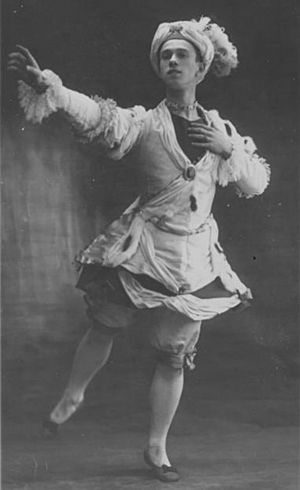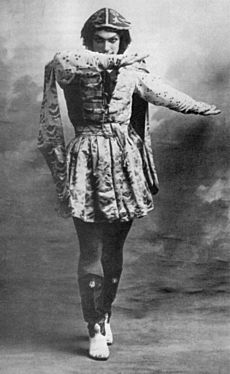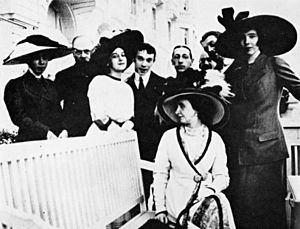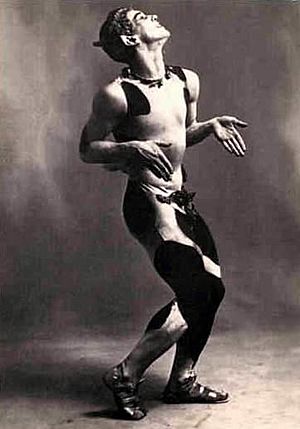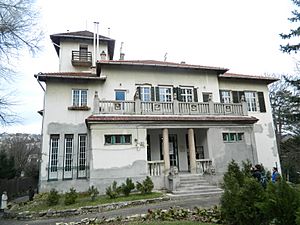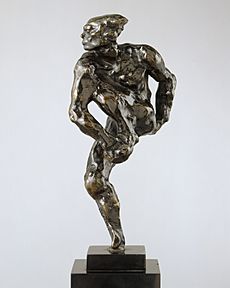Vaslav Nijinsky facts for kids
Quick facts for kids
Vaslav Nijinsky
|
|
|---|---|
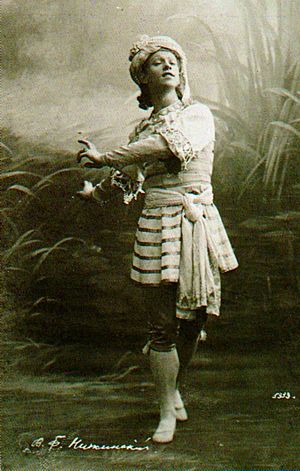
Vaslav Nijinsky as Vayou in Nikolai Legat's revival of Marius Petipa's The Talisman, St. Petersburg, 1909
|
|
| Born |
Wacław Niżyński
12 March 1889/1890 |
| Died | 8 April 1950 (aged 60–61) |
| Other names | Vatslav Nijinsky |
| Occupation | Ballet dancer, choreographer |
| Years active | 1908–1917 |
Vaslav Nijinsky (born 1889 or 1890 – died 1950) was a famous Russian ballet dancer and choreographer. He was of Polish background. Many people consider him the greatest male dancer of the early 1900s.
Nijinsky was known for his amazing skill and how deeply he brought characters to life. He could even dance en pointe (on the tips of his toes), which was very rare for male dancers back then. People also admired his leaps, which seemed to defy gravity.
His parents were also dancers, and he grew up touring with their opera company. His older brother Stanislav and younger sister Bronislava also became dancers. Bronislava later worked closely with Vaslav as a choreographer.
At age nine, Nijinsky was accepted into the Imperial Ballet School in St. Petersburg, Russia. This was the best ballet school in the world. He graduated in 1907 and joined the Imperial Ballet, quickly getting important roles.
In 1909, he joined the Ballets Russes, a new dance company started by Sergei Diaghilev. This company brought Russian ballets to Paris, where such high-quality performances were not well known. Nijinsky became the company's main male dancer and amazed audiences with his performances. Diaghilev helped Nijinsky grow as an artist, giving him chances to explore new dance styles and choreography. This made Nijinsky famous around the world.
Contents
Early Life and Training
Vaslav Nijinsky was born in 1889 or 1890 in Kiev, which was then part of the Russian Empire and is now Ukraine. His birth name was Wacław Niżyński. His parents, Tomasz Niżyński and Eleonora Bereda, were both Polish dancers who toured with a company.
Vaslav was christened in Warsaw. He considered himself Polish, even though he grew up in Russia and found it hard to speak Polish. His mother, Eleonora, became a dancer at a young age after her parents died. She became a solo dancer in Kiev. His father, Tomasz, also trained as a dancer and became a soloist.
His parents met and married in 1884. They worked with the traveling Setov opera company. Eleonora continued to dance while raising their three children: Stanislav, Vaslav, and Bronislava. Vaslav and Bronislava became very close as they grew up. Their older brother, Stanislav, had health issues and was later admitted to a hospital.
After the Setov company broke up, Vaslav's parents separated. His mother moved to St. Petersburg with her children. She arranged for Vaslav to join the Imperial Ballet School. Bronislava entered the school two years later.
Imperial Ballet School Days
In 1900, Nijinsky joined the Imperial Ballet School. He learned dance from famous teachers like Sergei Legat and Nikolai Legat. He also studied mime (acting without words) with Pavel Gerdt. All these teachers were lead dancers at the Imperial Russian Ballet.
After a trial period, his teachers agreed that Nijinsky had amazing dance talent. He was accepted as a full-time student. He performed in small roles in classic ballets like The Nutcracker and Sleeping Beauty. He also won a special scholarship.
Nijinsky did well in subjects he liked, but not in others. He was often chosen to be an extra in performances, which meant he missed classes. Some classmates were jealous of his talent. In 1901, one student caused him to fall, which led to a head injury.
In 1902, Mikhail Oboukhov became his teacher and gave him the highest grade he had ever given a student. Nijinsky performed for the Tsar in ballets like Paquita. He also studied music, playing piano, flute, and accordion. He was good at playing music by ear.
Sometimes, Nijinsky's behavior was wild. In 1903, he was briefly expelled from school for a prank. He was allowed back after a month.
In 1904, when he was 14, the famous choreographer Marius Petipa chose Nijinsky for a main role in a new ballet. However, the ballet was never performed because of the Russo-Japanese War.
On January 9, 1905, Nijinsky was caught in the Bloody Sunday event in St. Petersburg. Soldiers fired on a crowd of people trying to give a petition to the Tsar. Nijinsky was injured in the head.
As he got older, Nijinsky became calmer but still made few friends. He seemed quiet and unremarkable until he danced.
Starting His Career
In 1905, Nijinsky performed a special dance in the student show. His teacher changed the dance to highlight Nijinsky's skills. His first jump made the audience gasp and then applaud.
In 1906, he danced in a Mariinsky production. The director of the Imperial Ballet offered him a place in the company, even though he was a year from graduating. Nijinsky decided to finish his studies. He also tried choreographing a children's opera.
At his graduation in April 1907, he danced with Elizaveta Gerdt. He was congratulated by the lead ballerina, Mathilde Kschessinska, who invited him to dance with her. This guaranteed his future career. He graduated second in his class, with top grades in dancing, art, and music.
After graduating, Nijinsky performed at Krasnoe Selo for audiences that included the Imperial family. Each dancer who performed for the Tsar received a gold watch. With Nijinsky's new salary and his sister Bronia also working, the family moved to a bigger apartment. In September 1907, Nijinsky officially joined the Mariinsky Theatre.
He quickly became known for his technical skills, especially his leaps and turns. He amazed audiences with his ability to seem to fly during a dance from Sleeping Beauty. In 1910, he created a sensation as the Wind God Vayou in Le Talisman.
Joining the Ballets Russes
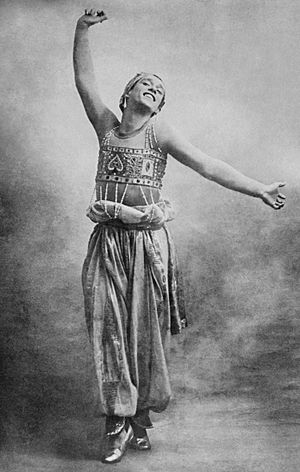
A big change for Nijinsky came when he met Sergei Diaghilev. Diaghilev was a famous and creative producer of ballet and opera. He wanted to promote Russian art in other countries, especially in Paris. His 1908 season of Russian ballets and operas was a huge success. This led him to start a new company, the famous Ballets Russes, for a 1909 tour.
Diaghilev worked closely with choreographer Michel Fokine and artist Léon Bakst. Nijinsky became the main dancer for the Ballets Russes. Diaghilev was very involved in guiding Nijinsky's career.
First Paris Season (1909)
Diaghilev planned the 1909 Paris tour with a team of designers, painters, and composers. Nijinsky was part of this group. His sister said he felt a bit nervous around such famous people. The company prepared ballets like Le Pavillon d'Armide and Les Sylphides. They also created a new ballet called Cléopâtre.
Diaghilev and Nijinsky traveled to Paris before the rest of the company. The Ballets Russes' Paris seasons were a huge artistic and social hit. They set new trends in art, dance, music, and fashion for the next ten years. Nijinsky's unique talent shone in ballets like Le Pavillon d'Armide and Cleopatra. His performance in a dance from The Sleeping Beauty was a massive success.
Later Seasons and New Roles
In 1910, Nijinsky performed in Giselle and Fokine's ballets Carnaval and Scheherazade. His portrayal of "Petrushka", a puppet with a soul, showed his amazing ability to act out characters. His partnership with Tamara Karsavina was legendary. They were called the "most excellent artists of the time."
In January 1911, he danced in Giselle at the Mariinsky Theatre in St. Petersburg. The Tsarina Alexandra Feodorovna was there. His costume caused a scandal because he danced in tights without the usual trousers. He refused to apologize and was dismissed from the Imperial Ballet. This meant he was now free to focus entirely on the Ballets Russes.
Nijinsky as a Choreographer

Nijinsky began to create his own ballets, pushing the boundaries of dance. His ballets included L'après-midi d'un faune (The Afternoon of a Faun, 1912), Jeux (1913), and Till Eulenspiegel (1916). These works introduced audiences to new, modern dance styles.
His ballet The Rite of Spring (Le Sacre du Printemps), with music by Igor Stravinsky (1913), was especially groundbreaking. Nijinsky's choreography used sharp, angular movements that were very different from traditional ballet. At its first performance in Paris, fights broke out in the audience between those who loved and hated this new style. The ballet's theme was a young maiden who dances herself to death as a sacrifice. The challenging music and choreography caused a huge uproar, which Diaghilev actually liked because it brought attention to the company.
Marriage and Later Career
Nijinsky's new ballets were controversial and took a lot of time to rehearse. Diaghilev asked him to prepare a new ballet, but then decided to bring back Fokine as choreographer instead. This caused tension between Diaghilev and Nijinsky.
In August 1913, the company went on a tour to South America. Nijinsky's sister Bronislava, who usually supported him, could not go because she was pregnant. Diaghilev also did not go on the tour. Nijinsky felt very unsettled during the long sea voyage without his usual advisors.
On this tour, Nijinsky met Romola de Pulszky, a Hungarian woman whose mother was a famous actress. Romola had seen Nijinsky dance in Budapest and was very impressed. She started following the Ballets Russes across Europe. Romola and Nijinsky did not share a common language, so they used an interpreter at first.
On the ship to South America, Romola spent more and more time with Nijinsky. An investor in the Ballets Russes, Baron de Gunsbourg, helped Nijinsky propose marriage to Romola. She accepted. They were married on September 10, 1913, in Buenos Aires, Argentina.
Leaving the Ballets Russes
When Nijinsky returned to Paris, Diaghilev did not meet him. Soon after, Diaghilev sent a telegram telling Nijinsky that he was no longer part of the Ballets Russes. Nijinsky had missed a performance in Rio when Romola was sick, and Diaghilev often dismissed dancers who married. Nijinsky had never had a formal contract or wages; Diaghilev had paid all his expenses.
Losing his place with the Ballets Russes was very difficult for Nijinsky. The Ballets Russes and the Imperial Russian Ballet were the top ballet companies in the world. Nijinsky was an experimental artist who needed new roles and the chance to choreograph. The Ballets Russes was the only company that could offer him this.
Nijinsky tried to form his own company and asked his sister Bronia to join him. She was worried about him coping without his usual support. However, the new company faced many problems. Scenery was late, and there wasn't enough time to rehearse. Nijinsky became very nervous and upset.
Diaghilev attended the opening night in March 1914. The audience was divided. Some had never seen ballet and didn't like the delays. Others had seen Nijinsky before and felt something was missing. On another night, Nijinsky became very angry when the orchestra played music during a scene change, which he had forbidden. He had to be calmed down to perform. The show was eventually canceled, and Nijinsky suffered a big financial loss. Newspapers reported that he had a nervous breakdown.
Later Life and Legacy
Romola became pregnant, and the couple moved to Budapest, Hungary, to her mother's house. Their daughter Kyra was born on June 19, 1914. When World War I began, Nijinsky was considered an enemy citizen because he was Russian. He was kept under house arrest in Budapest and could not leave.
Diaghilev tried to get Nijinsky released to dance for the Ballets Russes again. After complex talks and help from several international leaders, Nijinsky was allowed to go to New York in 1916 for an American tour. Romola handled the negotiations, demanding that Diaghilev pay Nijinsky for the years he had not received a salary.
Nijinsky arrived in New York in April 1916. He was to dance and manage a company of over 100 people. He also had to prepare two new ballets. Rehearsals for Till Eulenspiegel were difficult because Nijinsky struggled to explain what he wanted to the dancers. He would sometimes get very angry. He twisted his ankle, delaying the opening of the season. Despite the challenges, Nijinsky's performances were praised. However, his management of the tour was disorganized, leading to a large financial loss.

His last public performance was on September 30, 1917, in Montevideo, South America. He was 28 years old. Around this time, signs of his mental illness became clear. Nijinsky and his wife moved to St. Moritz, Switzerland, to recover from the tour's stresses. In 1917, his older brother Stanislav died in a hospital.
On January 19, 1919, Vaslav Nijinsky gave one last solo performance at a hotel in St. Moritz. His dance showed many feelings, from sadness and anger to joy. It also reflected his strong feelings about the war.
Nijinsky wrote a diary from January to March 1919. In it, he expressed his fear of being hospitalized. He drew many eyes, feeling that he was constantly watched. In 1919, Romola arranged for him to see a psychiatrist in Zurich. He was diagnosed with schizophrenia, a mental illness that affects a person's thinking, feeling, and behavior. He was then admitted to a mental hospital. In 1920, his second daughter, Tamara, was born. She never saw him dance in public.
For the next 30 years, Nijinsky was in and out of psychiatric hospitals. In 1945, after World War II, he met Russian soldiers playing folk music. Hearing the music from his youth, he began to dance, amazing the men. Laughing with them helped him start to speak again after many years of almost complete silence.
From 1947, Nijinsky lived in England with his wife. He died in London on April 8, 1950, from kidney failure. In 1953, his body was moved to Montmartre Cemetery in Paris.
Nijinsky's Diary
Nijinsky's diary was written during the six weeks he spent in Switzerland in 1919 before being hospitalized. It showed how his home life was becoming chaotic. He wrote about his feelings and actions. The diary combined parts of his life story with pleas for kindness toward those less fortunate.
Years later, his wife found three notebooks with his diary entries and another with letters. She published a version of the diary in 1936, but she removed about 40 percent of it. She took out parts that were not flattering to her or others. She also rearranged sections and made some of the stranger parts sound less unusual.
In 1995, the first complete version of The Diary of Vaslav Nijinsky was published. It showed that the diary displayed signs common in schizophrenia, such as unusual thoughts and disorganized language. A review in The New York Times said that the full diary restored Nijinsky's true voice and the amazing talent he had.
No Film of His Dancing
Many still photographs exist of Nijinsky dancing, taken by photographers like E. O. Hoppé. However, there is no film of Nijinsky performing. Diaghilev never allowed the Ballets Russes to be filmed. He believed that the film quality at the time was not good enough to capture the artistry of his dancers. He thought the company's reputation would suffer if people saw their performances only in the short, shaky films of that period.
Cultural Depictions
Nijinsky's life and work have inspired many artists.
In Ballet
- Nijinsky, Clown of God (1971) by Maurice Béjart.
- Vaslav (1979) by John Neumeier.
- Nijinsky – Divine Dancer (1990) by Joseph Hölderle and Juha Vanhakartano. This ballet was based on Nijinsky's diary.
- Nijinski by Marco Goecke, performed in Stuttgart, Germany.
In Plays
- A play about Nijinsky and Diaghilev was written by Terence Rattigan in the 1970s.
- A Cavalier for Milady: A Play in Two Scenes by Tennessee Williams includes a dream-like appearance by Nijinsky.
- David Pownall's Death of a Faun (1998) features Nijinsky after Diaghilev's death.
- Leonard Crofoot wrote Nijinsky Speaks (1998) as a solo show about the dancer's career.
- William Luce's Nijinsky (2000) premiered in Tokyo.
- ICONS: The Lesbian and Gay History of the World, Vol. 5 (2011) featured actor/playwright Jade Esteban Estrada as Nijinsky.
- Nijinsky – The Miraculous God of Dance (2011) was a Japanese production.
- Étonne-Moi (2014) was a Dutch solo play.
- Letter To a Man (2016) directed by Robert Wilson with Mikhail Baryshnikov is a stage version of Nijinsky's diaries.
In Film
- Nijinsky (1980), directed by Herbert Ross, starred George de la Peña as Nijinsky.
- Anna Pavlova (1983) featured Mikhaill Krapivin as Nijinsky.
- The Diaries of Vaslav Nijinsky (2001), directed by Paul Cox, was based on Nijinsky's diaries.
- Riot at the Rite (2005), a TV drama about The Rite of Spring premiere, starred Adam Garcia as Nijinsky.
- Nijinsky & Neumeier Soulmates in Dance (2009) is a documentary about Nijinsky's influence.
- Coco Chanel & Igor Stravinsky (2009) shows Nijinsky during the creation of The Rite of Spring.
In Fine Arts
In 2011, Poland unveiled its first sculpture of Vaslav Nijinsky and his sister Bronislava Nijinska. It shows them as the Faun and the Nymph from the ballet L’après-midi d’un faune. The sculpture was made by Giennadij Jerszow. Nijinsky was also portrayed by the famous sculptor Auguste Rodin.
In Music
- In 2011, Jade Esteban Estrada wrote the song "Beautiful" for a musical.
- The band Bauhaus mentions Nijinsky in their songs "Dancing" and "Muscle in Plastic."
- Italian singer Franco Battiato quotes Nijinsky in his song "Prospettiva Nevskj."
- Roxy Music refers to Nijinsky in their song "Do the Strand."
- English singer Marc Almond has a song called "My Nijinsky Heart" (2010).
In Competitive Skating
- In 2003, Russian figure skater Evgeni Plushenko created a routine called "Tribute to Vaslav Nijinsky." He earned a perfect score for artistic impression with this routine.
Images for kids
See also
 In Spanish: Vaslav Nijinsky para niños
In Spanish: Vaslav Nijinsky para niños
- List of dancers
- List of Russian ballet dancers



